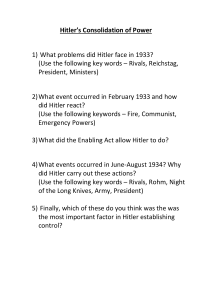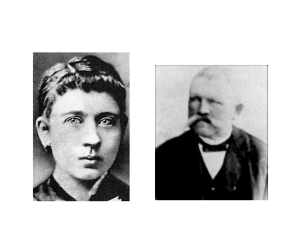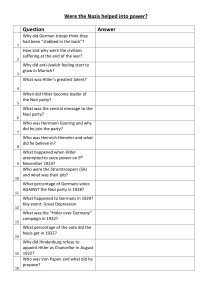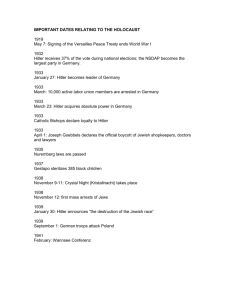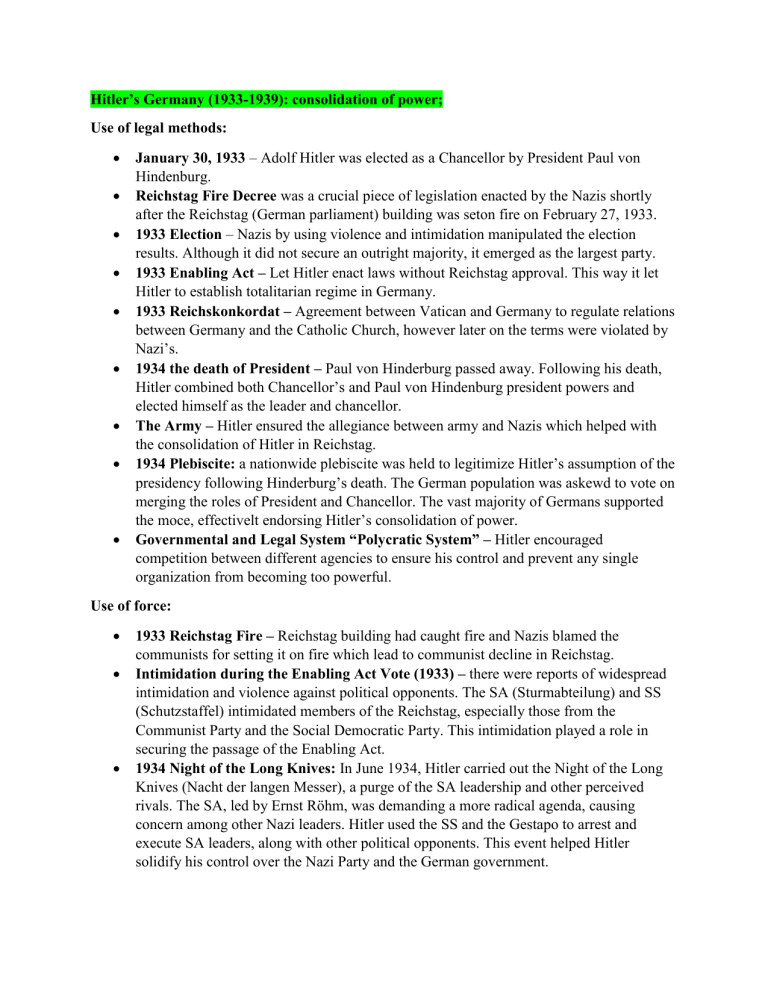
Hitler’s Germany (1933-1939): consolidation of power; Use of legal methods: January 30, 1933 – Adolf Hitler was elected as a Chancellor by President Paul von Hindenburg. Reichstag Fire Decree was a crucial piece of legislation enacted by the Nazis shortly after the Reichstag (German parliament) building was seton fire on February 27, 1933. 1933 Election – Nazis by using violence and intimidation manipulated the election results. Although it did not secure an outright majority, it emerged as the largest party. 1933 Enabling Act – Let Hitler enact laws without Reichstag approval. This way it let Hitler to establish totalitarian regime in Germany. 1933 Reichskonkordat – Agreement between Vatican and Germany to regulate relations between Germany and the Catholic Church, however later on the terms were violated by Nazi’s. 1934 the death of President – Paul von Hinderburg passed away. Following his death, Hitler combined both Chancellor’s and Paul von Hindenburg president powers and elected himself as the leader and chancellor. The Army – Hitler ensured the allegiance between army and Nazis which helped with the consolidation of Hitler in Reichstag. 1934 Plebiscite: a nationwide plebiscite was held to legitimize Hitler’s assumption of the presidency following Hinderburg’s death. The German population was askewd to vote on merging the roles of President and Chancellor. The vast majority of Germans supported the moce, effectivelt endorsing Hitler’s consolidation of power. Governmental and Legal System “Polycratic System” – Hitler encouraged competition between different agencies to ensure his control and prevent any single organization from becoming too powerful. Use of force: 1933 Reichstag Fire – Reichstag building had caught fire and Nazis blamed the communists for setting it on fire which lead to communist decline in Reichstag. Intimidation during the Enabling Act Vote (1933) – there were reports of widespread intimidation and violence against political opponents. The SA (Sturmabteilung) and SS (Schutzstaffel) intimidated members of the Reichstag, especially those from the Communist Party and the Social Democratic Party. This intimidation played a role in securing the passage of the Enabling Act. 1934 Night of the Long Knives: In June 1934, Hitler carried out the Night of the Long Knives (Nacht der langen Messer), a purge of the SA leadership and other perceived rivals. The SA, led by Ernst Röhm, was demanding a more radical agenda, causing concern among other Nazi leaders. Hitler used the SS and the Gestapo to arrest and execute SA leaders, along with other political opponents. This event helped Hitler solidify his control over the Nazi Party and the German government. The Gestapo, under the leadership of Rudolf Diels and later Heinrich Müller, was the official secret police of Nazi Germany. It operated to identify and eliminate political opposition, gathering intelligence and suppressing dissent. The Gestapo was known for its brutal methods and played a crucial role in implementing Nazi policies.


